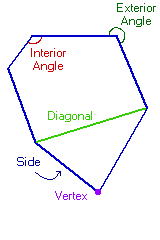|
What is a Polygon?
A closed plane figure made up of several line segments that are joined
together. The sides do not cross each other. Exactly two sides meet at
every vertex.
Types |
Formulas | Parts
| Special Polygons | Names
Types of Polygons
Regular - all angles are equal and all sides are the same length.
Regular polygons are both equiangular and equilateral.
Equiangular - all angles are equal.
Equilateral - all sides are the same length.
 |
Convex - a straight line drawn through a convex polygon crosses
at most two sides. Every interior angle is less than 180°. |
 |
Concave - you can draw at least one straight line through
a concave polygon that crosses more than two sides.
At least one interior angle is more than 180°. |
Polygon Formulas
(N = # of sides and S = length from center to a corner)
Area of a regular polygon = (1/2) N sin(360°/N) S2
Sum of the interior angles of a polygon = (N - 2) x 180°
The number of diagonals in a polygon = 1/2 N(N-3)
The number of triangles (when you draw all the diagonals from one
vertex) in a polygon = (N - 2)
Polygon Parts
 |
Side - one of the line segments
that make up the polygon.
Vertex - point where two sides
meet. Two or more of these points are called vertices.
Diagonal - a line connecting
two vertices that isn't a side.
Interior Angle - Angle formed
by two adjacent sides inside the polygon.
Exterior Angle - Angle formed
by two adjacent sides outside the polygon.
|
Special Polygons
Special
Quadrilaterals - square, rhombus, parallelogram, rectangle, and the
trapezoid.
Special
Triangles - right, equilateral, isosceles, scalene, acute, obtuse.
Polygon
Names
Generally accepted names
|
Sides
|
Name |
|
n
|
N-gon |
|
3
|
Triangle |
|
4
|
Quadrilateral |
|
5
|
Pentagon |
|
6
|
Hexagon |
|
7
|
Heptagon |
|
8
|
Octagon |
|
10
|
Decagon |
|
12
|
Dodecagon |
Names for other polygons have been proposed.
|
Sides
|
Name |
|
9
|
Nonagon, Enneagon |
|
11
|
Undecagon, Hendecagon |
|
13
|
Tridecagon, Triskaidecagon |
|
14
|
Tetradecagon, Tetrakaidecagon |
|
15
|
Pentadecagon, Pentakaidecagon |
|
16
|
Hexadecagon, Hexakaidecagon |
|
17
|
Heptadecagon, Heptakaidecagon |
|
18
|
Octadecagon, Octakaidecagon |
|
19
|
Enneadecagon, Enneakaidecagon |
|
20
|
Icosagon |
|
30
|
Triacontagon |
|
40
|
Tetracontagon |
|
50
|
Pentacontagon |
|
60
|
Hexacontagon |
|
70
|
Heptacontagon |
|
80
|
Octacontagon |
|
90
|
Enneacontagon |
|
100
|
Hectogon, Hecatontagon |
|
1,000
|
Chiliagon |
|
10,000
|
Myriagon |
To construct a name, combine the prefix+suffix
|
Sides
|
Prefix |
|
20
|
Icosikai... |
|
30
|
Triacontakai... |
|
40
|
Tetracontakai... |
|
50
|
Pentacontakai... |
|
60
|
Hexacontakai... |
|
70
|
Heptacontakai... |
|
80
|
Octacontakai... |
|
90
|
Enneacontakai... |
|
+
|
|
Sides
|
Suffix |
|
+1
|
...henagon |
|
+2
|
...digon |
|
+3
|
...trigon |
|
+4
|
...tetragon |
|
+5
|
...pentagon |
|
+6
|
...hexagon |
|
+7
|
...heptagon |
|
+8
|
...octagon |
|
+9
|
...enneagon |
|
Examples:
46 sided polygon - Tetracontakaihexagon
28 sided polygon - Icosikaioctagon
However, many people use the form n-gon, as in 46-gon, or 28-gon instead
of these names.

|

